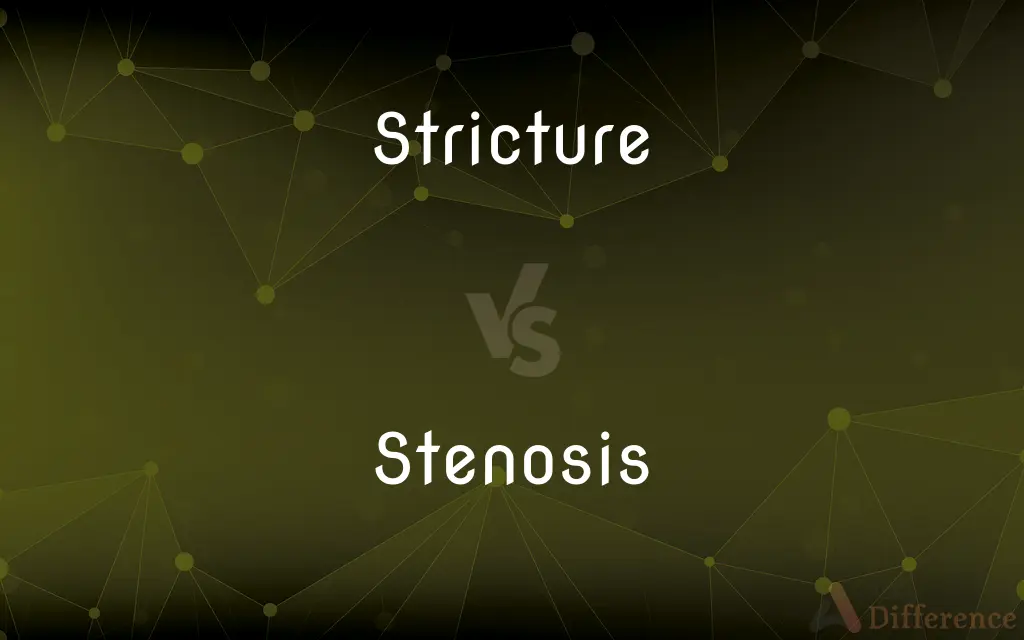Stricture vs. Stenosis — What's the Difference?
By Fiza Rafique & Urooj Arif — Updated on March 26, 2024
Stricture refers to abnormal narrowing of a passage or duct in body, often due to inflammation or scarring, while stenosis is a specific type of narrowing, typically of tubular structures, often caused by disease or condition.

Difference Between Stricture and Stenosis
Table of Contents
ADVERTISEMENT
Key Differences
While strictures are generally characterized by the narrowing caused by external pressure, tissue inflammation, or fibrosis leading to scar formation, stenosis often involves the internal constriction of a passage, which might be due to buildup within the vessel walls, degenerative diseases, or abnormalities in structure.
Treatment for strictures typically focuses on relieving the narrowing, which may involve procedures to physically widen the affected area, medication to treat underlying conditions, or surgery. In contrast, managing stenosis might include lifestyle changes, medication to manage symptoms or slow progression, and in some cases, surgical intervention to correct or bypass the narrowing.
The term "stricture" is broader, covering a range of conditions leading to narrowing, regardless of location or cause, implying a focus on the symptom rather than the specific underlying condition. "Stenosis" is used in more specific contexts, often in reference to particular diseases or anatomical locations, with a clear implication of the type of narrowing involved.
While both strictures and stenosis refer to the concept of narrowing within the body, the usage of each term depends on the location, cause, and nature of the narrowing, with strictures being a more general term and stenosis relating to specific conditions or anatomical narrowing.
Comparison Chart
Definition
Abnormal narrowing of a passage or duct, often due to inflammation or scarring.
Specific type of narrowing, typically of tubular structures, caused by disease or congenital conditions.
ADVERTISEMENT
Causes
Inflammation, injury, diseases like cancer.
Congenital anomalies, degenerative diseases, aging.
Characterization
Often results from external pressure, inflammation, or fibrosis.
Involves internal constriction, often due to buildup or structural abnormalities.
Treatment
Procedures to widen the area, medication, surgery.
Lifestyle changes, medication, surgical intervention.
Compare with Definitions
Stricture
May result from chronic inflammation or injury.
Repeated urinary tract infections can lead to stricture formation.
Stenosis
Associated with degenerative diseases or aging.
Lumbar stenosis is common in older youngs due to spinal degeneration.
Stricture
A narrowing caused by inflammation or scarring.
An esophageal stricture can make swallowing difficult.
Stenosis
Related to chronic conditions or congenital issues.
Congenital heart defects can include valvular stenosis.
Stricture
Can occur in various bodily ducts and passages.
Urethral stricture is a common condition affecting urine flow.
Stenosis
Involves internal constriction of passages.
Arterial stenosis can lead to restricted ischemia.
Stricture
Treatment aims to relieve narrowing.
Balloon dilation is a procedure used to treat strictures.
Stenosis
May require surgical intervention.
Severe cases of spinal stenosis might need decompressive surgery.
Stricture
Often involves fibrosis or external pressure.
Scar tissue from surgery can cause strictures in nearby organs.
Stenosis
A constriction or narrowing of a duct or passage; a stricture.
Stricture
A restriction on a person or activity
The strictures imposed by the British Board of Film Censors
Stenosis
A reduction in either mental or physical capacity.
Stricture
A sternly critical or censorious remark or instruction
His strictures on their lack of civic virtue
Stenosis
A narrowing of the opening or hollow of any passage, tube, or orifice; as, stenosis of the pylorus. It differs from stricture in being applied especially to diffused rather than localized contractions, and in always indicating an origin organic and not spasmodic.
Stricture
Abnormal narrowing of a canal or duct in the body
Jaundice caused by bile duct stricture
A colonic stricture
Stenosis
Abnormal narrowing of a bodily canal or passageway
Stricture
A restraint, limit, or restriction
Strictures placed on free assembly.
Strictures against food in the library.
The strictures of traditional gender roles.
Stricture
An abnormal narrowing of a bodily duct or passage.
Stricture
An adverse remark or criticism
"my writing ... which he praises sufficiently to give his strictures a good deal of force" (Virginia Woolf).
Stricture
A rule restricting behaviour or action.
Stricture
A general state of restrictiveness on behavior, action, or ideology.
I just couldn't take the stricture of that place a single day more.
Stricture
A sternly critical remark or review.
Stricture
(medicine) Abnormal narrowing of a canal or duct in the body.
Stricture
(obsolete) Strictness.
Stricture
(obsolete) A stroke; a glance; a touch.
Stricture
(linguistics) The degree of contact, in consonants.
Stricture
Strictness.
A man of stricture and firm abstinence.
Stricture
A stroke; a glance; a touch.
Stricture
A touch of adverse criticism; censure.
[I have] given myself the liberty of these strictures by way of reflection on all and every passage.
Stricture
A localized morbid contraction of any passage of the body. Cf. Organic stricture, and Spasmodic stricture, under Organic, and Spasmodic.
Stricture
Abnormal narrowing of a bodily canal or passageway
Stricture
Severe criticism
Common Curiosities
Can strictures lead to serious health issues?
Yes, strictures can lead to complications like blockages, infections, or difficulty in the normal functioning of affected organs, requiring timely diagnosis and treatment.
How are strictures treated?
Treatment for strictures may include procedures to widen the narrowed area, medication to address underlying causes, or surgery.
What is a stricture?
A stricture is the abnormal narrowing of any passage or duct in the body, often caused by inflammation, scarring, or disease.
Are certain people more at risk for developing a stricture?
Individuals with conditions that lead to chronic inflammation, those who have had certain types of surgery, or individuals with specific diseases like cancer may be at higher risk for developing strictures.
Can lifestyle changes prevent stenosis?
While lifestyle changes can help manage some risk factors associated with stenosis, they may not prevent congenital or degenerative forms of the condition.
Is stenosis reversible?
While some forms of stenosis can be managed or improved with treatment, many cases, particularly those related to degenerative diseases or aging, may not be fully reversible.
What causes stenosis?
Causes of stenosis include congenital anomalies, degenerative diseases, and the natural aging process, leading to the internal constriction of passages.
Are there any non-surgical treatments for stenosis?
Non-surgical treatments may include physical therapy, medications to relieve symptoms or slow disease progression, and lifestyle modifications.
How is stenosis diagnosed?
Stenosis is diagnosed using imaging techniques such as X-rays, MRI, or CT scans, often accompanied by symptom assessment and sometimes invasive diagnostic procedures.
How long does treatment for a stricture last?
The duration of treatment can vary widely based on the cause, severity, and response to initial treatments, ranging from short-term procedures to ongoing management.
Do both strictures and stenosis require surgery?
Surgery may be an option for both conditions, depending on severity and location, but not all cases require surgical intervention.
Can diet affect the development of strictures?
While diet alone isn't directly responsible for the development of strictures, healthy eating habits can support overall health and potentially reduce the risk of conditions that might lead to strictures.
Is it possible to have both a stricture and stenosis?
Yes, it's possible for an individual to have both conditions, depending on the affected areas and underlying health issues.
Share Your Discovery

Previous Comparison
Mount vs. Mountain
Next Comparison
Infrasound vs. UltrasoundAuthor Spotlight
Written by
Fiza RafiqueFiza Rafique is a skilled content writer at AskDifference.com, where she meticulously refines and enhances written pieces. Drawing from her vast editorial expertise, Fiza ensures clarity, accuracy, and precision in every article. Passionate about language, she continually seeks to elevate the quality of content for readers worldwide.
Co-written by
Urooj ArifUrooj is a skilled content writer at Ask Difference, known for her exceptional ability to simplify complex topics into engaging and informative content. With a passion for research and a flair for clear, concise writing, she consistently delivers articles that resonate with our diverse audience.















































